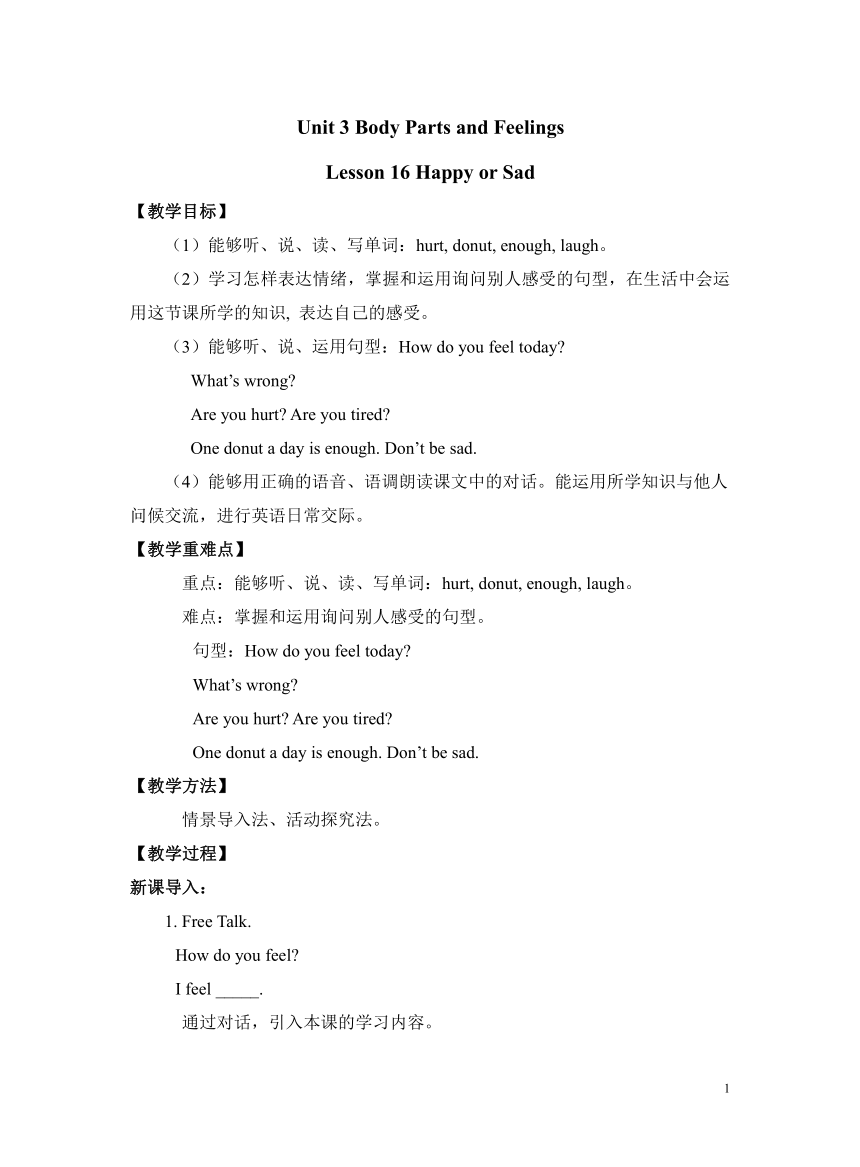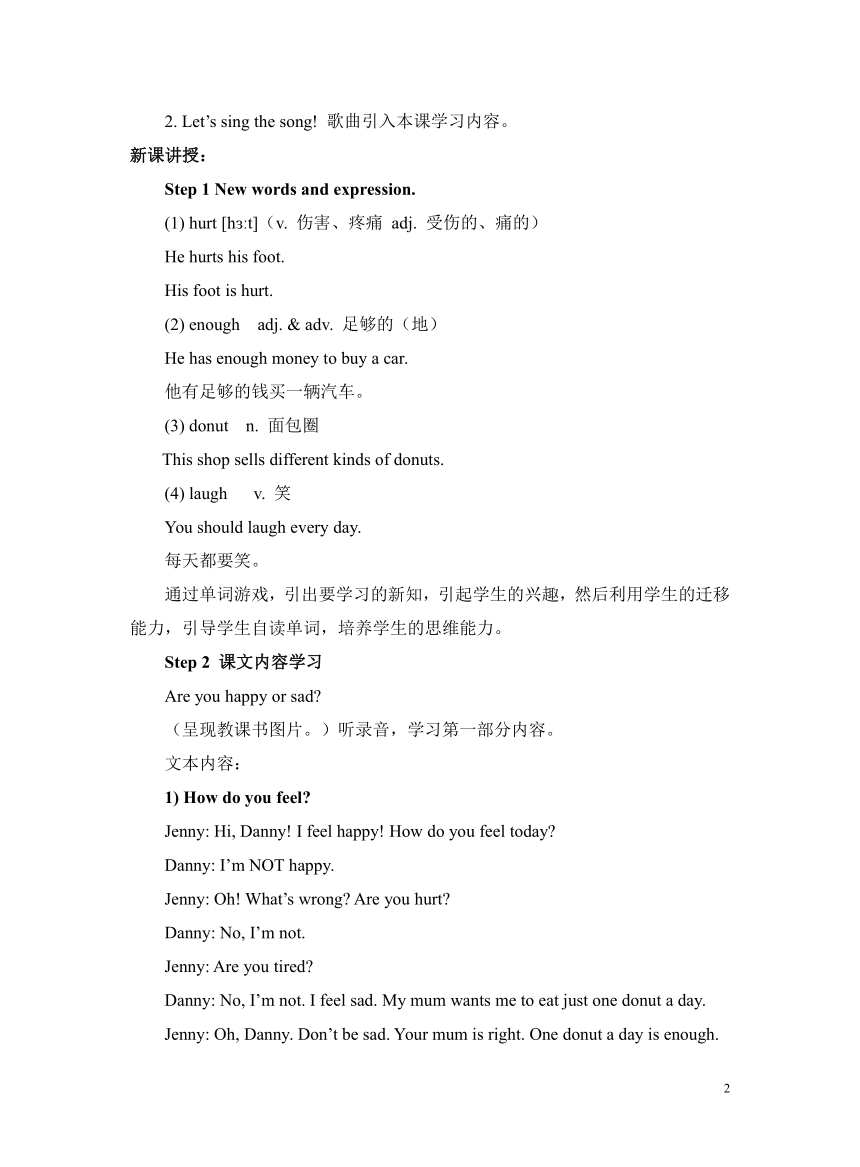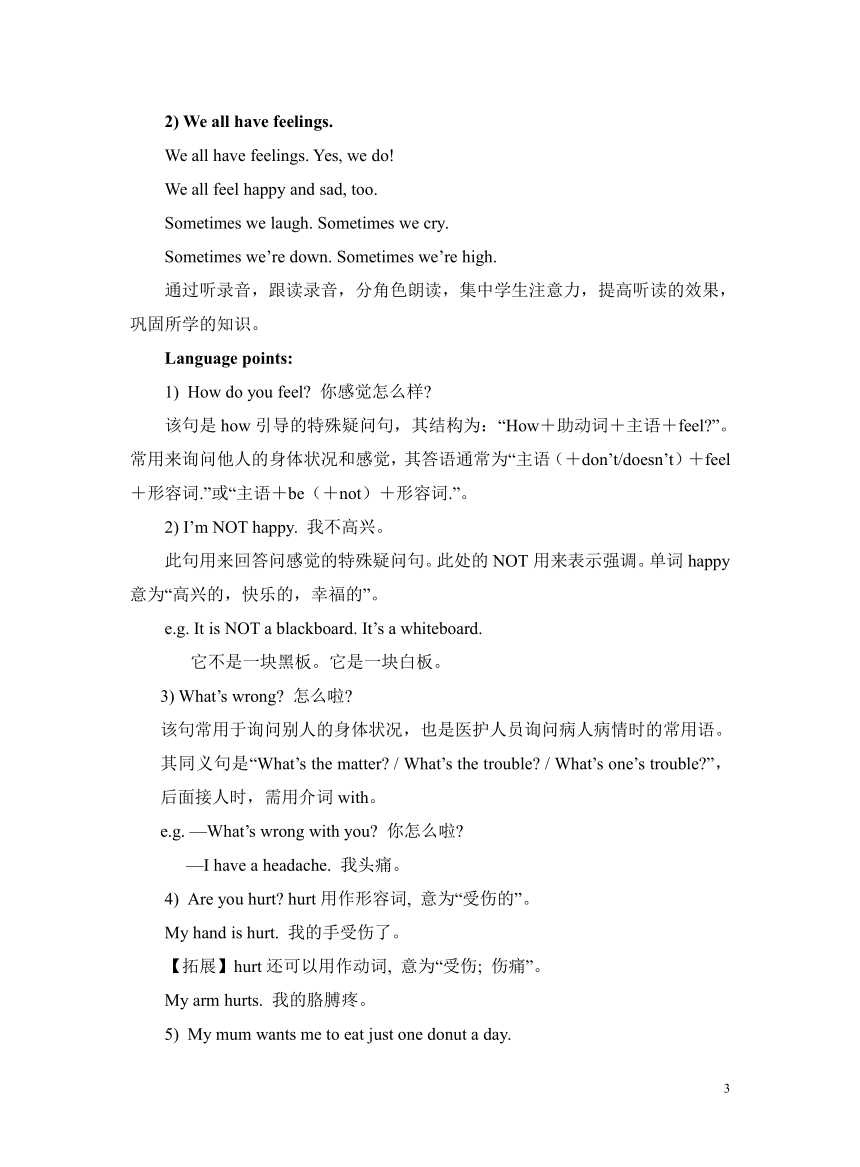冀教版英语七年级上册 Unit 3 Body Parts and Feelings Lesson 16 Happy or Sad 教案
文档属性
| 名称 | 冀教版英语七年级上册 Unit 3 Body Parts and Feelings Lesson 16 Happy or Sad 教案 |  | |
| 格式 | docx | ||
| 文件大小 | 21.3KB | ||
| 资源类型 | 教案 | ||
| 版本资源 | 冀教版 | ||
| 科目 | 英语 | ||
| 更新时间 | 2023-09-06 23:12:48 | ||
图片预览



文档简介
Unit 3 Body Parts and Feelings
Lesson 16 Happy or Sad
【教学目标】
(1)能够听、说、读、写单词:hurt, donut, enough, laugh。
(2)学习怎样表达情绪,掌握和运用询问别人感受的句型,在生活中会运用这节课所学的知识, 表达自己的感受。
(3)能够听、说、运用句型:How do you feel today
What’s wrong
Are you hurt Are you tired
One donut a day is enough. Don’t be sad.
(4)能够用正确的语音、语调朗读课文中的对话。能运用所学知识与他人问候交流,进行英语日常交际。
【教学重难点】
重点:能够听、说、读、写单词:hurt, donut, enough, laugh。
难点:掌握和运用询问别人感受的句型。
句型:How do you feel today
What’s wrong
Are you hurt Are you tired
One donut a day is enough. Don’t be sad.
【教学方法】
情景导入法、活动探究法。
【教学过程】
新课导入:
1. Free Talk.
How do you feel
I feel _____.
通过对话,引入本课的学习内容。
2. Let’s sing the song! 歌曲引入本课学习内容。
新课讲授:
Step 1 New words and expression.
(1) hurt [h t](v. 伤害、疼痛 adj. 受伤的、痛的)
He hurts his foot.
His foot is hurt.
(2) enough adj. & adv. 足够的(地)
He has enough money to buy a car.
他有足够的钱买一辆汽车。
(3) donut n. 面包圈
This shop sells different kinds of donuts.
(4) laugh v. 笑
You should laugh every day.
每天都要笑。
通过单词游戏,引出要学习的新知,引起学生的兴趣,然后利用学生的迁移能力,引导学生自读单词,培养学生的思维能力。
Step 2 课文内容学习
Are you happy or sad
(呈现教课书图片。)听录音,学习第一部分内容。
文本内容:
1) How do you feel
Jenny: Hi, Danny! I feel happy! How do you feel today
Danny: I’m NOT happy.
Jenny: Oh! What’s wrong Are you hurt
Danny: No, I’m not.
Jenny: Are you tired
Danny: No, I’m not. I feel sad. My mum wants me to eat just one donut a day.
Jenny: Oh, Danny. Don’t be sad. Your mum is right. One donut a day is enough.
2) We all have feelings.
We all have feelings. Yes, we do!
We all feel happy and sad, too.
Sometimes we laugh. Sometimes we cry.
Sometimes we’re down. Sometimes we’re high.
通过听录音,跟读录音,分角色朗读,集中学生注意力,提高听读的效果,巩固所学的知识。
Language points:
How do you feel 你感觉怎么样
该句是how引导的特殊疑问句,其结构为:“How+助动词+主语+feel ”。常用来询问他人的身体状况和感觉,其答语通常为“主语(+don’t/doesn’t)+feel+形容词.”或“主语+be(+not)+形容词.”。
2) I’m NOT happy. 我不高兴。
此句用来回答问感觉的特殊疑问句。此处的NOT用来表示强调。单词happy意为“高兴的,快乐的,幸福的”。
e.g. It is NOT a blackboard. It’s a whiteboard.
它不是一块黑板。它是一块白板。
3) What’s wrong 怎么啦
该句常用于询问别人的身体状况,也是医护人员询问病人病情时的常用语。其同义句是“What’s the matter / What’s the trouble / What’s one’s trouble ”,后面接人时,需用介词with。
e.g. —What’s wrong with you 你怎么啦
—I have a headache. 我头痛。
Are you hurt hurt用作形容词, 意为“受伤的”。
My hand is hurt. 我的手受伤了。
【拓展】hurt还可以用作动词, 意为“受伤; 伤痛”。
My arm hurts. 我的胳膊疼。
My mum wants me to eat just one donut a day.
◆want用作动词, 意为“想要”。want sth.意为“想要……”; want sb. to do sth.意为“想要某人做某事”。
Jim wants a new schoolbag.
吉姆想要一个新书包。
Mary wants her sister to do her homework. 玛丽想让她的妹妹做作业。
◆just用作副词, 相当于only, 意为“仅仅, 只是”。
I eat just an apple today. 我今天只吃了一个苹果。
6) One donut a day is enough.
enough作形容词, 意思是“足够的; 充分的”。
Five men will be quite enough.
五个人就足够了。
【拓展】enough常与for或不定式连用, 可以作定语或表语。作定语置于被修饰的名词前后均可, 前置时强调enough, 后置时强调被修饰词。
The house is big enough for us.
这个房子对我们来说够大了。
We have enough food. 我们有足够的食物。
Step 3 Let’s Do It!
1. Read the lesson and answer the questions.
2. Listen to the conversations and number the pictures.
3. Complete the mind map with feeling words.
4. Fill in the blanks with the words in the box.
5. Work in pairs. How do you feel today Make up a dialogue.
Role play
1. Role play the conversation in groups;
2. Role play the conversation in front of the class.
课堂练习:
根据句意和首字母, 写出单词, 使句子意思完整
1. She is h________. She always smiles.
2. His mother is in hospital (住院). He feels s_____.
3. Everyone (每个人) has a mouth and a n_____.
4. I see with my e______ and hear with my e_______.
5. The boy has two b____ eyes and short hair.
二、单项选择
1. —How do you feel —_______.
A. No, I’m sad B. I feel happy
C. I’m here D. Yes, I’m happy
2. —Are you sad —_______.
A. No, I’m not. I just feel tired B. I’m happy
C. Sure, I’m OK D. Fine, thanks
3. —_______ —My eye hurts.
A. Are you happy B. What’s wrong
C. How do you feel D. What do you do
三、按要求完成下列各题
1. sleep, want, to, I
__________________________________.
2. Jenny, down, feels
__________________________________.
3. feel, how, your, mother, does, today
___________________________________
4. drink, water, our, teacher, wants, to, us, every, day
__________________________________________.
5. buy, enough, I, money, have, to, coat, this
__________________________________________.
课堂小结:
T: What did you learn about this lesson
学生自由说,教师总结。
语言知识:
1) 识记以下单词: hurt, donut, enough, laugh
2) 掌握短语及句型: How do you feel today
What’s wrong
Are you hurt Are you tired
One donut a day is enough. Don’t be sad.
语言技能:
1)能运用所学知识与他人问候交流。
2)听懂并能进行英语日常交际。。
将本节课所学的知识进行归纳,帮助学生理解和记忆,巩固提升本课时所学的知识。
作业布置:
完成配套课后练习。
【板书设计】
Lesson 16 Happy or Sad
词汇:hurt, donut, enough, laugh
句型:How do you feel today
What’s wrong
Are you hurt Are you tired
One donut a day is enough. Don’t be sad.
【课后反思】
本课时的教学内容是冀教版七年级上册英语第三单元的第四课时, 重点在于引导学生理解语境, 从关心对方的感受开始, 自然地导入描述感受的话题。以询问对方的感受作为任务引起学生的听说兴趣, 训练学生的听力和口语表达能力。利用实物和图片学习英语单词, 同时在对话中反复运用新学的单词和短语。因此, 教师可以将知识目标定为掌握本课时新出现的词和短语, 如何询问对方感受的句型。
1
Lesson 16 Happy or Sad
【教学目标】
(1)能够听、说、读、写单词:hurt, donut, enough, laugh。
(2)学习怎样表达情绪,掌握和运用询问别人感受的句型,在生活中会运用这节课所学的知识, 表达自己的感受。
(3)能够听、说、运用句型:How do you feel today
What’s wrong
Are you hurt Are you tired
One donut a day is enough. Don’t be sad.
(4)能够用正确的语音、语调朗读课文中的对话。能运用所学知识与他人问候交流,进行英语日常交际。
【教学重难点】
重点:能够听、说、读、写单词:hurt, donut, enough, laugh。
难点:掌握和运用询问别人感受的句型。
句型:How do you feel today
What’s wrong
Are you hurt Are you tired
One donut a day is enough. Don’t be sad.
【教学方法】
情景导入法、活动探究法。
【教学过程】
新课导入:
1. Free Talk.
How do you feel
I feel _____.
通过对话,引入本课的学习内容。
2. Let’s sing the song! 歌曲引入本课学习内容。
新课讲授:
Step 1 New words and expression.
(1) hurt [h t](v. 伤害、疼痛 adj. 受伤的、痛的)
He hurts his foot.
His foot is hurt.
(2) enough adj. & adv. 足够的(地)
He has enough money to buy a car.
他有足够的钱买一辆汽车。
(3) donut n. 面包圈
This shop sells different kinds of donuts.
(4) laugh v. 笑
You should laugh every day.
每天都要笑。
通过单词游戏,引出要学习的新知,引起学生的兴趣,然后利用学生的迁移能力,引导学生自读单词,培养学生的思维能力。
Step 2 课文内容学习
Are you happy or sad
(呈现教课书图片。)听录音,学习第一部分内容。
文本内容:
1) How do you feel
Jenny: Hi, Danny! I feel happy! How do you feel today
Danny: I’m NOT happy.
Jenny: Oh! What’s wrong Are you hurt
Danny: No, I’m not.
Jenny: Are you tired
Danny: No, I’m not. I feel sad. My mum wants me to eat just one donut a day.
Jenny: Oh, Danny. Don’t be sad. Your mum is right. One donut a day is enough.
2) We all have feelings.
We all have feelings. Yes, we do!
We all feel happy and sad, too.
Sometimes we laugh. Sometimes we cry.
Sometimes we’re down. Sometimes we’re high.
通过听录音,跟读录音,分角色朗读,集中学生注意力,提高听读的效果,巩固所学的知识。
Language points:
How do you feel 你感觉怎么样
该句是how引导的特殊疑问句,其结构为:“How+助动词+主语+feel ”。常用来询问他人的身体状况和感觉,其答语通常为“主语(+don’t/doesn’t)+feel+形容词.”或“主语+be(+not)+形容词.”。
2) I’m NOT happy. 我不高兴。
此句用来回答问感觉的特殊疑问句。此处的NOT用来表示强调。单词happy意为“高兴的,快乐的,幸福的”。
e.g. It is NOT a blackboard. It’s a whiteboard.
它不是一块黑板。它是一块白板。
3) What’s wrong 怎么啦
该句常用于询问别人的身体状况,也是医护人员询问病人病情时的常用语。其同义句是“What’s the matter / What’s the trouble / What’s one’s trouble ”,后面接人时,需用介词with。
e.g. —What’s wrong with you 你怎么啦
—I have a headache. 我头痛。
Are you hurt hurt用作形容词, 意为“受伤的”。
My hand is hurt. 我的手受伤了。
【拓展】hurt还可以用作动词, 意为“受伤; 伤痛”。
My arm hurts. 我的胳膊疼。
My mum wants me to eat just one donut a day.
◆want用作动词, 意为“想要”。want sth.意为“想要……”; want sb. to do sth.意为“想要某人做某事”。
Jim wants a new schoolbag.
吉姆想要一个新书包。
Mary wants her sister to do her homework. 玛丽想让她的妹妹做作业。
◆just用作副词, 相当于only, 意为“仅仅, 只是”。
I eat just an apple today. 我今天只吃了一个苹果。
6) One donut a day is enough.
enough作形容词, 意思是“足够的; 充分的”。
Five men will be quite enough.
五个人就足够了。
【拓展】enough常与for或不定式连用, 可以作定语或表语。作定语置于被修饰的名词前后均可, 前置时强调enough, 后置时强调被修饰词。
The house is big enough for us.
这个房子对我们来说够大了。
We have enough food. 我们有足够的食物。
Step 3 Let’s Do It!
1. Read the lesson and answer the questions.
2. Listen to the conversations and number the pictures.
3. Complete the mind map with feeling words.
4. Fill in the blanks with the words in the box.
5. Work in pairs. How do you feel today Make up a dialogue.
Role play
1. Role play the conversation in groups;
2. Role play the conversation in front of the class.
课堂练习:
根据句意和首字母, 写出单词, 使句子意思完整
1. She is h________. She always smiles.
2. His mother is in hospital (住院). He feels s_____.
3. Everyone (每个人) has a mouth and a n_____.
4. I see with my e______ and hear with my e_______.
5. The boy has two b____ eyes and short hair.
二、单项选择
1. —How do you feel —_______.
A. No, I’m sad B. I feel happy
C. I’m here D. Yes, I’m happy
2. —Are you sad —_______.
A. No, I’m not. I just feel tired B. I’m happy
C. Sure, I’m OK D. Fine, thanks
3. —_______ —My eye hurts.
A. Are you happy B. What’s wrong
C. How do you feel D. What do you do
三、按要求完成下列各题
1. sleep, want, to, I
__________________________________.
2. Jenny, down, feels
__________________________________.
3. feel, how, your, mother, does, today
___________________________________
4. drink, water, our, teacher, wants, to, us, every, day
__________________________________________.
5. buy, enough, I, money, have, to, coat, this
__________________________________________.
课堂小结:
T: What did you learn about this lesson
学生自由说,教师总结。
语言知识:
1) 识记以下单词: hurt, donut, enough, laugh
2) 掌握短语及句型: How do you feel today
What’s wrong
Are you hurt Are you tired
One donut a day is enough. Don’t be sad.
语言技能:
1)能运用所学知识与他人问候交流。
2)听懂并能进行英语日常交际。。
将本节课所学的知识进行归纳,帮助学生理解和记忆,巩固提升本课时所学的知识。
作业布置:
完成配套课后练习。
【板书设计】
Lesson 16 Happy or Sad
词汇:hurt, donut, enough, laugh
句型:How do you feel today
What’s wrong
Are you hurt Are you tired
One donut a day is enough. Don’t be sad.
【课后反思】
本课时的教学内容是冀教版七年级上册英语第三单元的第四课时, 重点在于引导学生理解语境, 从关心对方的感受开始, 自然地导入描述感受的话题。以询问对方的感受作为任务引起学生的听说兴趣, 训练学生的听力和口语表达能力。利用实物和图片学习英语单词, 同时在对话中反复运用新学的单词和短语。因此, 教师可以将知识目标定为掌握本课时新出现的词和短语, 如何询问对方感受的句型。
1
同课章节目录
- Unit 1 School and friends
- Lesson 1 Hello!
- Lesson 2 Teacher and Students
- Lesson 3 Welcome to Our School
- Lesson 4 What Is It?
- Lesson 5 May I Have a Book?
- Lesson 6 Things for School
- Unit 2 Colours and Clothes
- Lesson 7 Jenny's New Skirt
- Lesson 8 Danny's Favourit Colou
- Lesson 9 Whose Coat Is This?
- Lesson 10 Clothes for a Cold Day
- Lesson 11 Clothes around the World
- Lesson 12 Let's Go Shopping!
- Unit 3 Body Parts and Feelings
- Lesson 13 Body Parts
- Lesson 14 Colours and Feelings
- Lesson 15 Tall or Short
- Lesson 16 Happy or Sad
- Lesson 17 Seeing a Docto
- Lesson 18 We All Look Different!
- Unit 4 Food and Restaurants
- Lesson 19 Time for Breakfast!
- Lesson 20 I Like the Supermarket!
- Lesson 21 At the Market
- Lesson 22 In the Restaurant
- Lesson 23 The Corner Store
- Lesson 24 Eat Good Food!
- Unit 5 Family and Home
- Lesson 25 Jenny's Family
- Lesson 26 Li Ming's Family
- Lesson 27 Danny at Home
- Lesson 28 A Family Picnic
- Lesson 29 A Birthday Card
- Lesson 30 Grandma's Birthday Party
- Unit 6 Let's Go!
- Lesson 31 Let's Go to the Bookstore!
- Lesson 32 At the Supermarket
- Lesson 33 Let's Go to the Zoo!
- Lesson 34 On the Farm
- Lesson 35 Let's Go to the Museum!
- Lesson 36 Let's Go to the Movie Theatre!
- Unit 7 Days and Months
- Lesson 37 Seasons and Weathe
- Lesson 38 Nick's Busy Month
- Lesson 39 A Class Calenda
- Lesson 40 When Is Your Birthday?
- Lesson 41 Holidays
- Lesson 42 Happy Holidays!
- Unit 8 Countries around the world
- Lesson 43 Directions
- Lesson 44 Jack's Goodbye Party
- Lesson 45 China
- Lesson 46 Canada and the U.S.
- Lesson 47 The U.K. and Australia
- Lesson 48 English-Speaking Countries
